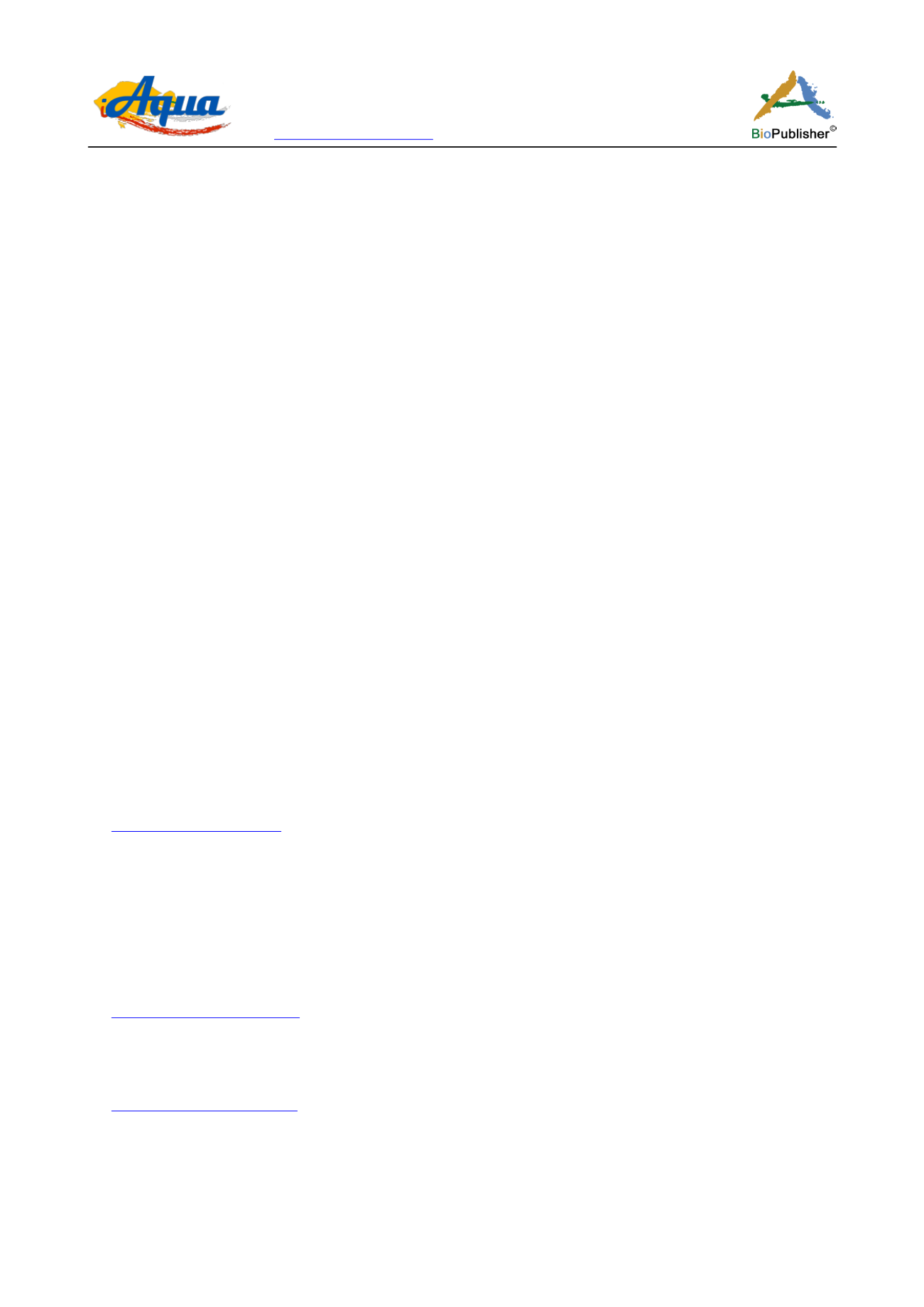
International Journal of Aquaculture, 2016, Vol.6, No.22, 1
-
11
10
oxidation and breakdown resulting in the deterioration in oxygen. This agrees with the works of Taiwo et al., (2014).
Dissolved oxygen values obtained in this study were below WHO (2004) permissible limit of 8 mg/L for discharged
into water and standard for sustaining life of 5 mg/l. A concentration below this value will adversely affect aquatic
biological life, while concentration below 2 mg/L may lead to death for most fishes (Chapman, 1992). This implies
that the dissolves oxygen in station A can adversely sustain life while stations B, C, and D were slightly below the
permissible limit. Dissolved oxygen fluctuate within the months showed almost uniform values across the stations
except in station C where there slight increase in dissolved oxygen in the month of January.
Alkalinity was lowest in station A (59.10 mg/l) and highest in station B (189.40 mg/l) which is within the
permissible limit of WHO (2004). The high in alkalinity in station B and C could be due to decomposition of organic
of the water at this station. Alkalinity was similar across the study period which disagrees with the work of The
seasonality in total alkalinity in this study is in agreement with the observation of Hall et al. (1977) in the middle
and lower Zambezi estuary.
This study showed that Wurukum abattoir impairs the health of River Benue as evidenced in that
macroinvertebrates found in stations B and C such as
Chironomus larvae, Eristali tennax, Macrobdella decora
are
pollution tolerant organisms. Also the presence of high values of Biochemical Oxygen Demand, Total Dissolved
Solids, Electrical Conductivity and low Dissolved Oxygen in stations B and C is was an indication of presence of
organic waste discharge into the river from the abattoir. The Abundance Biomass Comparison curve also indicated
that site Band C was polluted as evidenced by the curve for abundance overlapping that for biomass.
It is therefore recommended the activities of Wurukum Abattoir should be monitored closely by relevant agencies
(Benue State Ministry of Environment) in order to prevent full blown environment al problem and attendance health
hazard in the near future. The abattoir effluent could be effectively recycled into arable crop usage due to the high
nutrient value. This might rid the environmental of high organic load discharge v the abattoir.
References
Adakole J.A., and Anunne P.A., 2003, Benthic macroinvertebrates as indicators of environmental quality of an urban stream, Zaria, Northern Nigeria, Journal
of aquatic Sciences, 18(2), 85-92
Adeyemi S.O., Adikwu L.A., Akombu P.M., and Iyela J.T., 2011, Survey of zooplankton and macroinvertebrates of Gbedikere lake, Bassa, Kogy state, Nigeria,
Odonatologica, 40(3), 262
Agard J.B.R., Gobin J., and Warwick R.M., 1993, Analysis of marine macrobenthic community structure in relation to pollution, natural oil seepage and
seasonal disturbance in a tropical environment (Trinidad, West Indies), Marine Ecology Progress Series, 92(3), 233-243
Aguoru C.U., and Audu G., 2012, Studies on the range of plankton in river Benue, North Central Nigeria Western Africa, Greener Journal of Biological
Sciences, 2(2), 028-034
Akaahan T.J., Leke L., Eneji I.S., 2015, Seasonal Variation in Hydrochemistry of River Benue at Makurdi, Benue state, Nigeria, International Journal of
Environmental and Pollution, 3: 67-78
Akahaan T.J., 2014, Studies on benthic fauna as bio indicators of pollution in river benue makurdi, benue state, Nigeria, Int. Res. J. Environment Sci., Vol. 3(7),
33-38
APHA, 1992, Standard methods for the examination of water and wastewater, 18th Edition, Method 4500-O
Arimoro F.O., and Osakwe E.I., 2006, The influence of sawmill wood wastes on the distribution and population of macroinvertebrates at Benin River, Niger
Delta Area, Nigeria, Chemistry & biodiversity, 3(5), 578-592
PMid:17193293
Brinkhurst R.O., 1970, Organic Pollution, In: Pollution; Causes, Effect and Control, Ed. Harrison, R.R. the Royal
Chapman, D. (1992). Water Quality Assessments, a Guide to Use of Biota Sediments and Water in Environmental Monitoring. 1st Edn.UNESCO /UNEP,
Chapman and Hall, London pp 371- 460
Chirhart J., 2003, Development of a Macroinvertebrate Index of Biological Integrity (MIBI) for rivers and streams of the St. Croix River Basin in Minnesota,
Minnesota Pollution Control Agency Biological Monitoring Program, St. Paul


